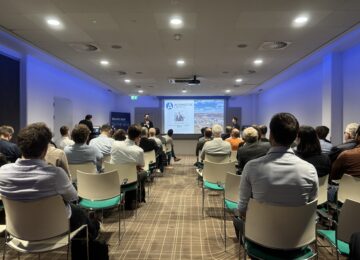'Dutch 130-hour battery makes hydrogen-powered gas plants obsolete'
In order to get through dark and windless periods, the Netherlands will need gas power plants running on green hydrogen in the future, concludes TenneT after research. A bad idea, argues CEO Guido Dalessi of battery manufacturer Elestor. Large batteries that can store electricity for long periods are much more efficient and cheaper and will make gas power plants redundant.
Network operator TenneT recently did research to an energy system without CO2 emissions (net zero) that is both reliable and affordable. Conclusion: to get through periods of insufficient wind and sun - the so-called "Dunkelflaute" - large batteries and gas power plants running on green hydrogen are needed. Dalessi agrees with the former, not the latter.
Two thirds of energy thrown away
In fact, those hydrogen-fueled gas plants are only needed 10 percent of the time. Moreover, it is not efficient to first turn green electricity into hydrogen through an electrolyser and then turn that hydrogen into green electricity again through combustion or in a fuel cell. "At each step you have about 60 percent efficiency, so in total you are throwing away two-thirds of your energy," he calculates. "That is not justifiable as long as we are still generating far too little green power and electric cars are still mainly running on fossil energy from coal-fired power plants. Moreover, you have to keep such a hydrogen power plant operational all year long only to occasionally supplement it. That's very expensive, because you need both an electrolyser and a gas power plant to do that."
Battery enough for Dunkelflaute
Elestor did a similar research as TenneT. Again, the premise was to generate all power as cheaply as possible from solar and wind. "Also our conclusion was that this is possible. But our research found that periods without solar and wind generation of power last up to 130 hours. This was shown by analyzing historical data on wind and solar power generation over an entire year. Solar and wind are fairly complementary. So when the sun doesn't shine, it often blows and vice versa," Dalessi said. "Those 130 hours can easily be covered by a battery like ours. It can even store power for longer periods of time if needed. Moreover, you can also use it to balance the voltage on the grid and thus not just for Dunkelflaute. Then you won't need gas power plants at all."
Operational after summer
The battery Elestor makes is a so-called hydrogen bromide flow battery. This is a completely different technology from the commonly used lithium-ion batteries. Those are relatively expensive, can store power for a relatively short time and the extraction of lithium causes a lot of environmental pollution. The Arnhem-based company uses relatively inexpensive and ubiquitous substances: bromine and hydrogen. Elestor's batteries consist of two storage tanks, one containing hydrogen and one containing hydrogen bromide. Between them is a membrane where a chemical reaction takes place. When electric voltage is applied to the battery, the hydrogen bromide splits into hydrogen and bromine. That hydrogen is collected in the separate tank. When discharging, hydrogen and bromine combine again, releasing electricity. Then the process can begin again.
That way, the battery can be charged and discharged thousands of times without losing capacity. The first commercial version of the battery will be built at Vopak in Vlissingen later this year. That has a capacity of 3 megawatt hours and will become operational in the second half of this year. "That's still a small one. After that, we will scale it up to 250 megawatt hours," Dalessi said.
Hydrogen for industry
Using batteries instead of gas power plants is not new, according to him. It is already happening in America, where energy company Vistra will eventually replace its backup gas power plants with 6,000-megawatt batteries. Elestor's batteries, according to Dalessi, are like bi-directional power plants, both supplying power and taking it away when there are surpluses. Because they are modular, you can make them as big as you need them. Dalessi: "Don't get me wrong, I'm not against hydrogen. The green variety will have an important role in the energy transition. To get a CO2-free electricity system, we will soon have to generate 50 percent more green electricity than we need. We can then make hydrogen from that surplus. But let's use it for industry and possibly hydrogen-powered cars, not to generate electricity through gas-fired power plants. That's very inefficient. If you really want to innovate towards a new energy system we should not keep the old systems alive."
Source: change.inc





